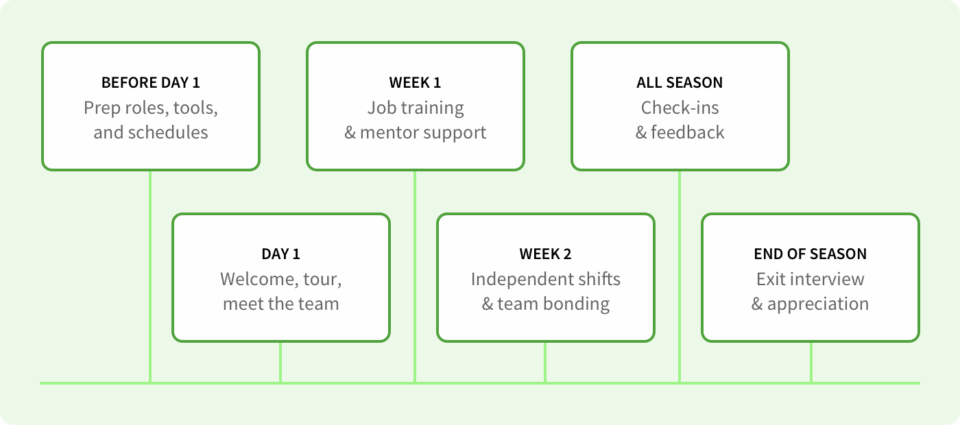The Art Of Onboarding Seasonal Employees: A Step-By-Step Guide
Try When I Work for free
Learn how onboarding seasonal employees can make for a more successful busy season and help your team feel more cohesive. Use this step -by -step guide for a seasonal staff onboarding process to have them ramp up faster, boost morale, and increase retention. You’ll learn how to structure your seasonal employee training to make it the most effective and efficient.
Key takeaways
- Understanding the needs of seasonal employees and how they’re different from your full-time workers can help you create a better onboarding experience.
- Being ready for your new seasonal employees is an important part of onboarding, so be sure to prepare accordingly.
- Treat onboarding seasonal employees as you would a full-time worker—just because seasonal workers won’t be there for a long time doesn’t mean they don’t need all the information to do their job correctly.
- Be sure to have an offboarding process in place when the season is over so you know what went well and can make improvements for next year.
- Great onboarding sets up your seasonal workers for success, which makes them happier and more productive.
Almost 74,000 people do some sort of seasonal work in the U.S. every year. Do you have some new employees joining your team for the holidays or to help your business through the busy season? Bringing in some seasonal staff can help your team thrive during a surge in demand.
But what do you need to do after you pick your team? Onboarding, of course! Think of onboarding as a welcome party for your new workers. It’s how they learn all of the important things about the job and get to feel like part of the team.
While you may have your onboarding process figured out, onboarding seasonal employees is a little different. Even if they’re only around for a little while, you want them to feel welcome. When they understand their jobs and feel satisfied, they perform better at work. And that’s good for everyone!
This guide will teach you the ins and outs of onboarding seasonal employees.
Understanding the unique needs of seasonal employees
Not all workers are the same. Seasonal employees are unique because they’re only with you for a short time. Unlike full-time employees, seasonal workers may be a part of your team for only a few weeks or months.
Seasonal workers need to know what to do quickly, get their questions answered, and feel like part of the team. But onboarding seasonal employees fast is only part of the equation. You also need to integrate them into your team to avoid friction with full-time staff.
Preparing for the onboarding process
Onboarding seasonal employees requires preparation. Don’t wait until the day they arrive to start getting ready to welcome them. Instead, set the stage for a smooth transition by preparing to do the following:
- Set clear goals: Clearly tell seasonal employees what their job is—they should know what tasks they need to do each day.
- Make them feel welcome: A big smile and a friendly “Hey! Welcome to the team!” can make them feel included from the beginning.
- Have everything they need ready: Gather the necessary work tools and uniforms, and designate a spot where they can keep their things.
First impressions matter, especially when onboarding seasonal employees. Make sure their first day is smooth and frictionless.
Also, don’t skimp on the gear. If the seasonal employees need it for their job, make sure they get it on day one. Issuing them the same equipment and tools as full-time employees will make them feel like part of the team.
The onboarding process step-by-step
No matter what industry you work in, you should use the same basic steps when onboarding seasonal employees. You can apply a lot of principles that you use to onboard new full-time staff. However, the main difference is the time frame. You need to get seasonal staff up to speed fast.
Let’s break down how you can help your seasonal staff hit the ground running.
Step 1: Welcome and introduction
Start with a warm welcome. Tell them what’s great about the company. You could even tell them some interesting details about the business, like a funny event or how the company started.
Who are the people they’ll work with? Introduce them and give them some friendly faces to remember. Also, make sure they get a chance to meet their direct supervisor.
Make the first day special. A little “Welcome” sign, a personalized name tag, or an ID badge goes a long way. You can also offer some refreshments. Keep it simple and stick to fan favorites like coffee and donuts.
If you really want to make the first day one for the books, organize a little meet-and-greet. Let some of your managers and experienced workers join in. This is a good way for new workers to get a feel for the company’s culture and values.

Step 2: Orientation
Once you’ve gotten the new hires warmed up to your team, it’s time to start orientation. But don’t just toss the policy manual at them.
Instead, try playing tour guide. Show them the important spots—where they’ll work, where they can take breaks, and where the nearest bathroom is. While you’re at it, start introducing them to the important rules they need to know about.
You’ve made them feel welcome and given them a lay of the land. Now you can hit the books. Some topics to cover include:
- Company policies: Start with the basics and focus on the rules that apply to their position.
- Health and safety guidelines: Always emphasize safety, well-being, and health.
- Expectations: Recap your expectations—cover everything from clocking in and out to greeting customers.
- Culture: Give a high-level overview of your company culture, mission, and values.
Orientation is about getting everyone on the same page. You can also take this time to learn a little about your seasonal workforce.
Step 3: Training
Training is more than just telling new employees what buttons to push or which boxes to lift. It’s about helping them understand the why behind it.
Why is their role important? How does it make a difference for the business? If possible, pair them with a senior work mentor—someone who’s been around and knows the ropes.
The buddy system is a great way of onboarding seasonal employees. Most people learn best by watching.
Also, remember that training is a two-way street. Don’t just talk to them. Encourage them to ask, share, and be curious. The more they know, the higher their confidence will be.
Step 4: Integration
Finally, it is time to integrate your seasonal workers into the team. Don’t just cut them loose and assign them a shift. Conclude seasonal employee onboarding with a team-building event.
Once they have the hang of things, host a pizza day. Or you could even organize a project or fun team-building activity. A little competition and some laughs can bring your full-time and seasonal staff together.
By the end of onboarding, your seasonal workers should feel like a real part of the team. When people bond, they work better together. And that’s a win-win for everyone.
Make employee scheduling, time tracking, and team communication easier for everyone, full-time or seasonal, with When I Work. Sign up today for your free trial and see how it can work for your business.
Continuous support and feedback
Onboarding seasonal employees is only the beginning. Reinforce the great first impression you created by doing the following:
- Conduct regular check-ins: Don’t just turn seasonal workers loose after onboarding; check in with them to gauge how they’ve adjusted.
- Set up feedback channels: Make sure seasonal workers have a means of offering feedback—you want to promote open, honest communication.
- Address concerns promptly: If a seasonal worker voices a concern, address it quickly; everyone will take notice of how you handle these concerns.
Basically, you should manage seasonal workers in much the same way you oversee full-time staff. Engage with them. Communicate regularly. Make them feel valued.
Seasonal workers who are undervalued can adopt the “it’s not my problem” mindset. They know they won’t be there a year from now, which means they might be tempted to cut corners.
On the other hand, seasonal workers who feel like a part of the team will want to do their best daily. Offering continuous feedback and support helps build this sense of ownership over their work.
Offboarding
Once the season ends, give your workers a big thank you. Before they leave, you should:
- Gather feedback: Talk to your new seasonal hires and see how the experience went; gather feedback and actually listen to what they have to say.
- Show appreciation: Temporary staff like to receive recognition—include them in the employee of the week/month announcements and other staff appreciation efforts.
- Conduct exit interviews: Find out what went well and what didn’t—every seasonal employee can provide useful insights about your company and culture.
Seasonal employees are a great asset to your business. Treat them as such.
Gathering feedback can help you prepare for next season’s hiring process. Likewise, making seasonal workers feel valued can encourage them to come back next year.
Make it easier to adjust the work schedule before, during, and after your seasonal workers are on the job. Sign up for your free trial of When I Work today to find out how much time you can save each week.
Setting seasonal employees up for success
Onboarding seasonal employees boils down to setting a great first impression. Great onboarding means happy workers who deliver for your customers. A well-structured onboarding process can:
- Improve team chemistry
- Boost morale
- Get seasonal workers up to speed fast
- Eliminate friction
- Encourage seasonal staff to come back next year
- Enhance the customer experience
- Make the job easier for everyone
Want to simplify the process of onboarding seasonal employees? When I Work can help. Our user-friendly scheduling and team management platform takes the hassle out of overseeing your staff. Easily add users, build schedules, and communicate with staff. Start your free 14-day trial of When I Work today!






